E. M. Forster
Edward Morgan Forster OM CH (1 January 1879 – 7 June 1970) was an English novelist, short story writer, essayist and librettist. Many of his novels examine class difference and hypocrisy, including A Room with a View (1908), Howards End (1910) and A Passage to India (1924). The last brought him his greatest success. He was nominated for the Nobel Prize in Literature in 16 separate years.[1][2]
E. M. Forster | |
|---|---|
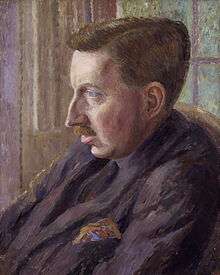 E. M. Forster, by Dora Carrington c. 1924–1925 | |
| Born | Henry Morgan Forster 1 January 1879 Marylebone, England |
| Died | 7 June 1970 (aged 91) Coventry, England |
| Occupation | Writer (novels, short stories, essays) |
| Alma mater | King's College, Cambridge |
| Period | 1901–1970 |
| Genre | Realism, symbolism, modernism |
| Subject | Class division, gender, homosexuality |
| Signature |  |
Early years
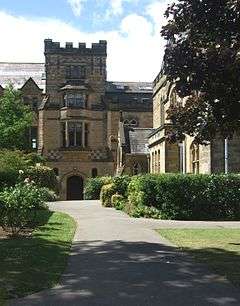
Forster, born at 6 Melcombe Place, Dorset Square, London NW1, a building no longer standing, was the only child of the Anglo-Irish Alice Clara "Lily" (née Whichelo) and a Welsh architect, Edward Morgan Llewellyn Forster. He was registered as Henry Morgan Forster, but accidentally baptised Edward Morgan Forster.[3] His father died of tuberculosis on 30 October 1880 before Morgan's second birthday.[4] In 1883, he and his mother moved to Rooks Nest, near Stevenage, Hertfordshire until 1893. This served as a model for Howards End in his novel of that name. It is listed Grade I for historic interest and literary associations.[5] He had fond memories of his childhood there.
Among Forster's ancestors were members of the Clapham Sect, a social reform group within the Church of England. Forster inherited £8,000 in trust (the equivalent of about £990,000 in 2017)[6] from his paternal great-aunt Marianne Thornton (daughter of the abolitionist Henry Thornton), who died on 5 November 1887.[7] The money was enough to live on and enabled him to become a writer. He attended as a day boy Tonbridge School in Kent, where the school theatre has been named in his honour,[8] although he is known to have been unhappy there.[9]
At King's College, Cambridge, between 1897 and 1901,[10] he became a member of a discussion society known as the Apostles (formally named the Cambridge Conversazione Society). They met in secret, and discussed their work on philosophical and moral questions. Many of its members went on to constitute what came to be known as the Bloomsbury Group, of which Forster was a member in the 1910s and 1920s. There is a famous recreation of Forster's Cambridge at the beginning of The Longest Journey. The Schlegel sisters of Howards End are based to some degree on Vanessa and Virginia Stephen.[11]
In 1904, Forster travelled in Greece and Italy as he was interested in their classical heritage. He then sought a post in Germany so that he could learn the language, and he spent several months in the summer of 1905 in Nassenheide, Pomerania, (now the Polish village of Rzędziny) working as a tutor to the children of the writer Elizabeth von Arnim; he wrote a short memoir of this experience which was one of the happiest times in his life.[12][13]
Forster was gay. In 1906 he fell in love with Syed Ross Masood, a 17-year-old Indian future Oxford student he tutored in Latin. Masood had a more romantic, poetic view of friendship, confusing Forster with avowals of love.[14]
After leaving university, he travelled in continental Europe with his mother. They moved to Weybridge, Surrey, where he wrote all six of his novels.
In 1914, he visited Egypt, Germany and India with the classicist Goldsworthy Lowes Dickinson, by which time he had written all but one of his novels.[15] As a conscientious objector in the First World War, Forster served as a Chief Searcher (for missing servicemen) for the British Red Cross in Alexandria, Egypt.[16] Though conscious of his repressed desires, it was only at this time, while stationed in Egypt, that he "lost his R [respectability]" to a wounded soldier in 1917.[17]
Forster spent a second spell in India in the early 1920s as private secretary to Tukojirao III, Maharajah of Dewas. The Hill of Devi is his non-fictional account of this period. After returning to London from India, he completed the last novel of his to be published in his lifetime, A Passage to India (1924), for which he won the James Tait Black Memorial Prize for fiction. He also edited the letters of Eliza Fay (1756–1816) from India, in an edition first published in 1925.[18] In 2012, Tim Leggatt, who knew Forster for his last 15 years, wrote a memoir using unpublished correspondence with him dating from those years.[19]
After A Passage to India
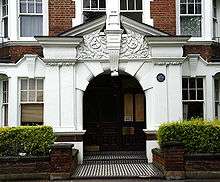
Forster was awarded a Benson Medal in 1937. In the 1930s and 1940s Forster became a notable broadcaster on BBC Radio, and while George Orwell was the BBC India Section talks producer from 1941 to 1943, he commissioned from Forster a weekly book review.[20] Forster became publicly associated with the British Humanist Association. In addition to his broadcasting, he advocated individual liberty and penal reform and opposed censorship by writing articles, sitting on committees and signing letters.
Forster was homosexual (open to his close friends, but not to the public) and a lifelong bachelor.[21] He developed a long-term relationship with Bob Buckingham (1904–1975), a married policeman.[22] Forster included Buckingham and his wife May in his circle, which included J. R. Ackerley, a writer and literary editor of The Listener, the psychologist W. J. H. Sprott, and for a time, the composer Benjamin Britten. Other writers with whom Forster associated included Christopher Isherwood, the poet Siegfried Sassoon, and the Belfast-based novelist Forrest Reid. He was a close friend of the socialist poet and philosopher Edward Carpenter, and it was a visit to Carpenter and his much younger lover George Merrill in 1913 that inspired Forster's novel Maurice, which is partly based on the couple.[23]
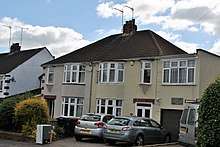
From 1925 until his mother's death at age 90 in March 1945, Forster lived with her at the house West Hackhurst in the village of Abinger Hammer, Surrey, finally leaving in September 1946.[24] His London base was 26 Brunswick Square from 1930 to 1939, after which he rented 9 Arlington Park Mansions in Chiswick until at least 1961.[25][26] After a fall in April 1961, he spent his final years in Cambridge at King's College.[27]
Forster was elected an honorary fellow of King's College, Cambridge, in January 1946,[25] and lived for the most part in the college, doing relatively little. In April 1947 he arrived in America to begin a three-month nationwide tour of public readings and sightseeing, returning to the East Coast in June.[28] He declined a knighthood in 1949 and was made a Companion of Honour in 1953.[25] At age 82, he wrote his last short story, Little Imber, a science fiction tale. According to his friend Richard Marquand, Forster was highly critical of American foreign policy in his latter years. This was one of the reasons why he consistently refused offers to adapt his novels for the screen, because Forster felt that such productions would inevitably involve American financing.[29]
At 85 he went on a pilgrimage to the Wiltshire countryside that had inspired his favourite novel The Longest Journey, escorted by William Golding.[28] In 1969 he was made a member of the Order of Merit. Forster died of a stroke[30] on 7 June 1970 at the age of 91, at the Buckinghams' home in Coventry, Warwickshire.[25] His ashes, mingled with those of Buckingham, were later scattered in the rose garden of Coventry's crematorium, near Warwick University.[31][32]
Novels
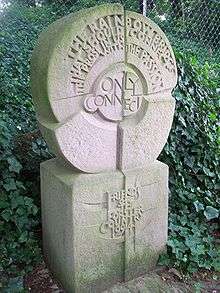
Forster had five novels published in his lifetime. Although Maurice was published shortly after his death, it had been written nearly sixty years earlier. He never finished a seventh novel, Arctic Summer.
His first novel, Where Angels Fear to Tread (1905), is the story of Lilia, a young English widow who falls in love with an Italian, and of the efforts of her bourgeois relatives to get her back from Monteriano (based on San Gimignano). Philip Herriton's mission to retrieve her from Italy has features in common with that of Lambert Strether in Henry James's The Ambassadors. Forster discussed that work ironically and somewhat disapprovingly in his book Aspects of the Novel (1927). Where Angels Fear to Tread was adapted as a 1991 film directed by Charles Sturridge.
Next, Forster published The Longest Journey (1907), an inverted Bildungsroman following the lame Rickie Elliott from Cambridge to a career as a struggling writer and then to a post as a schoolmaster, married to the unappealing Agnes Pembroke. In a series of scenes on the hills of Wiltshire, which introduce Rickie's wild half-brother Stephen Wonham, Forster attempts a kind of sublime related to those of Thomas Hardy and D. H. Lawrence.
.jpg)
Forster's third novel, A Room with a View (1908), is his lightest and most optimistic. It was started as early as 1901, before any of his others; its earliest versions are entitled Lucy. The book explores the young Lucy Honeychurch's trip to Italy with her cousin, and the choice she must make between the free-thinking George Emerson and the repressed aesthete Cecil Vyse. George's father Mr Emerson quotes thinkers who influenced Forster, including Samuel Butler. The book was adapted as a film of the same name in 1985 by the Merchant Ivory team, starring Helena Bonham Carter and Daniel Day-Lewis, and as a televised adaptation of the same name in 2007 by Andrew Davies.
Where Angels Fear to Tread and A Room with a View can be seen collectively as Forster's Italian novels. Both include references to the famous Baedeker guidebooks and concern narrow-minded middle-class English tourists abroad. The books share many themes with his short stories collected in The Celestial Omnibus and The Eternal Moment.
Howards End (1910) is an ambitious "condition-of-England" novel concerned with different groups within the Edwardian middle classes, represented by the Schlegels (bohemian intellectuals), the Wilcoxes (thoughtless plutocrats) and the Basts (struggling lower-middle-class aspirants). Critics have observed that numerous characters in Forster's novels die suddenly. This is true of Where Angels Fear to Tread, Howards End and, most particularly, The Longest Journey. Howards End was adapted as a film in 1992 by the Merchant-Ivory team, starring Vanessa Redgrave, Emma Thompson, Anthony Hopkins, and Helena Bonham-Carter. Emma Thompson would win the Academy Award for Best Actress for her performanceas Margaret Schlegel. It was also adapted as a miniseries in 2017. An opera libretto Howards End, America was created in 2016 by Claudia Stevens.
Forster achieved his greatest success with A Passage to India (1924). The novel takes as its subject the relationship between East and West, seen through the lens of India in the later days of the British Raj. Forster connects personal relationships with the politics of colonialism through the story of the Englishwoman Adela Quested, the Indian Dr. Aziz, and the question of what did or did not happen between them in the Marabar Caves. Forster makes special mention of the author Ahmed Ali and his Twilight in Delhi in his Preface to its Everyman's Library Edition. A Passage to India was adapted as a play in 1960, directed by Frank Hauser, and as a film in 1984, directed by David Lean.
Maurice (1971) was published posthumously. It is a homosexual love story that also returns to matters familiar from Forster's first three novels, such as the suburbs of London in the English home counties, the experience of attending Cambridge, and the wild landscape of Wiltshire. The novel was controversial, given that Forster's homosexuality had not been previously known or widely acknowledged. Today's critics continue to argue over the extent to which Forster's sexuality and personal activities influenced his writing.[34] Maurice was adapted as a film in 1987 by the Merchant Ivory team.
Early in his writing career, Forster attempted a historical novel about the Byzantine scholar Gemistus Pletho and the Italian condottiero Sigismondo de Malatesta, but was not satisfied with the result and never published it, though he kept the manuscript and later showed it to Naomi Mitchison.[35]
Critical reception
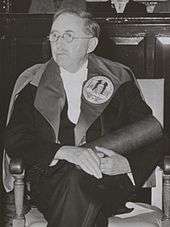
Forster's first novel, Where Angels Fear to Tread, was described by reviewers as "astonishing" and "brilliantly original".[36] The Manchester Guardian (forerunner of The Guardian) noted "a persistent vein of cynicism which is apt to repel," though "the cynicism is not deep-seated." The novel is labelled "a sordid comedy culminating, unexpectedly and with a real dramatic force, in a grotesque tragedy."[37] Lionel Trilling remarked on this first novel as "a whole and mature work dominated by a fresh and commanding intelligence".[38]
Subsequent books were similarly received on publication. The Manchester Guardian commented on Howards End, describing it as "a novel of high quality written with what appears to be a feminine brilliance of perception... witty and penetrating."[39] An essay by David Cecil in Poets and Storytellers (1949) describes Forster as "pulsing with intelligence and sensibility", but primarily concerned with an original moral vision: "He tells a story as well as anyone who ever lived".[40]
US interest in Forster and appreciation for him were spurred by Lionel Trilling's E. M. Forster: A Study, which called him "the only living novelist who can be read again and again and who, after each reading, gives me what few writers can give us after our first days of novel-reading, the sensation of having learned something." (Trilling 1943)
Criticism of his works has included comment on unlikely pairings of characters who marry or get engaged, and the lack of realistic depiction of sexual attraction.[40]
Key themes
Forster was President of the Cambridge Humanists from 1959 until his death and a member of the Advisory Council of the British Humanist Association from 1963 until his death. His views as a humanist are at the heart of his work, which often depicts the pursuit of personal connections in spite of the restrictions of contemporary society. His humanist attitude is expressed in the 1938 non-fictional essay What I Believe (reprinted with two other humanist essays – and an introduction and notes by Nicolas Walter – as What I Believe, and other essays by the secular humanist publishers G. W. Foote & Co. in 1999). When Forster's cousin, Philip Whichelo, donated a portrait of Forster to the Gay and Lesbian Humanist Association (GLHA), Jim Herrick, the founder, quoted Forster's words: "The humanist has four leading characteristics – curiosity, a free mind, belief in good taste, and belief in the human race."
Forster's two best-known works, A Passage to India and Howards End, explore the irreconcilability of class differences. A Room with a View also shows how questions of propriety and class can make human connection difficult. The novel is his most widely read and accessible work, remaining popular long after its original publication. His posthumous novel Maurice explores the possibility of class reconciliation as one facet of a homosexual relationship.
Sexuality is another key theme in Forster's works. Some critics have argued that a general shift from heterosexual to homosexual love can be observed through the course of his writing career. The foreword to Maurice describes his struggle with his homosexuality, while he explored similar issues in several volumes of short stories. Forster's explicitly homosexual writings, the novel Maurice and the short story collection The Life to Come, were published shortly after his death.
Forster is noted for his use of symbolism as a technique in his novels, and he has been criticised (as by his friend Roger Fry) for his attachment to mysticism. One example of his symbolism is the wych elm tree in Howards End. The characters of Mrs Wilcox in that novel and Mrs Moore in A Passage to India have a mystical link with the past, and a striking ability to connect with people from beyond their own circles. Henry James, E. M. Forster and Somerset Maugham were the earliest fiction writers to portray characters from diverse countries – France, Germany, Italy and India. Their work explores cultural conflict, but arguably the motifs of humanism and cosmopolitanism are dominant. In a way this is anticipation of the concept of human beings shedding national identities and becoming more and more liberal and tolerant.
Notable works by Forster
Novels
Short stories
|
Plays and pageants
Film scripts
Libretto
Collections of essays and broadcasts
Literary criticism
Biography
Travel writing
Miscellaneous writings
|
Notable films and drama based upon Forster's fiction
- The Machine Stops (1966), dramatised for the BBC anthology series Out of the Unknown
- A Passage to India (1984), dir. David Lean
- A Room with a View (1985), dir. James Ivory
- Maurice (1987), dir. James Ivory
- Where Angels Fear to Tread (1991), dir. Charles Sturridge
- Howards End (1992), dir. James Ivory
- Howards End (2017), BBC One miniseries, dir. Hettie MacDonald
- The Inheritance (2018), play by Matthew Lopez, adapted from Howards End, and featuring Forster as a character
References
- "Edward M Forster". Nomination Database. Nobel Media. Archived from the original on 2 April 2015. Retrieved 5 April 2015.
- "E Forster". Nomination Database. Nobel Media. Archived from the original on 12 October 2014. Retrieved 26 October 2016.
- Moffatt, p. 26.
- AP Central – English Literature Author: E. M. Forster Archived 13 March 2012 at the Wayback Machine. Apcentral.collegeboard.com (18 January 2012). Retrieved on 10 June 2012.
- Historic England. "Rooks News House Howards (1176972)". National Heritage List for England. Retrieved 16 January 2020.
- UK Retail Price Index inflation figures are based on data from Clark, Gregory (2017). "The Annual RPI and Average Earnings for Britain, 1209 to Present (New Series)". MeasuringWorth. Retrieved 2 February 2020.
- "A Chronology of Forster's life and work". Cambridge.org. 1 December 1953. Archived from the original on 24 September 2015. Retrieved 21 August 2010.
- "E. M. Forster Theatre, Tonbridge School". Tonbridge-school.co.uk. Archived from the original on 28 August 2010. Retrieved 21 August 2010.
- "British Museum site. Retrieved 7 August 2019". Archived from the original on 10 September 2016. Retrieved 25 August 2016.
- "Forster, Edward Morgan (FRSR897EM)". A Cambridge Alumni Database. University of Cambridge.
- Sellers, Susan (ed.) (2010). The Cambridge Companion to Virginia Woolf. England: Cambridge University Press. p. 16. ISBN 978-0521896948.CS1 maint: extra text: authors list (link)
- Sully, R. (2012) British Images of Germany: Admiration, Antagonism & Ambivalence, 1860-1914, p.120. New York: Springer. Retrieved 20 July 2020 (Google Books)
- E.M. Forster, (1920-1929) 'Nassenheide'. The National Archives. Retrieved 18 July 2020
- White, Edmund (6 November 2014). "Forster in Love: The Story". The New York Review of Books. ISSN 0028-7504. Archived from the original on 12 April 2018. Retrieved 11 April 2018.
- Lionel Trilling, E. M. Forster, p. 114. Archived 2 May 2014 at the Wayback Machine
- "British Red Cross volunteer records". Archived from the original on 5 September 2018. Retrieved 4 September 2018.
- Leith, Sam (13 June 2010). "EM Forster's work tailed off once he finally had sex. Better that than a life of despair". The Guardian. Archived from the original on 6 March 2016. Retrieved 12 March 2018.
- Original Letters from India (New York: NYRB, 2010 [1925]) ISBN 978-1-59017-336-7.
- Leggatt, T. W. (Timothy W.) (2012). Connecting with E.M Forster: a memoir. London. ISBN 9781843913757. OCLC 828203696.
- Orwell, George (1987). The War Broadcasts. Penguin Books. ISBN 978-0-14-018910-0.
- "Britain Unlimited Biography". Britainunlimited.com. 7 June 1970. Archived from the original on 22 September 2017. Retrieved 21 August 2010.
- Brooks, Richard (6 June 2010). "Sex Led to EM Forster's End". The Times. London. Archived from the original on 15 June 2011. Retrieved 6 June 2010.
- Kate Symondson (25 May 2016) E M Forster’s gay fiction . The British Library website. Retrieved 18 July 2020
- "King's College Archive Centre, Cambridge, The Papers of Edward Morgan Forster (reference EMF/19/6)". Archived from the original on 22 January 2009. Retrieved 27 May 2008.
- David Bradshaw, ed. (2007). "Chronology". The Cambridge Companion to E. M. Forster. Cambridge University Press. ISBN 978-0-521-83475-9. Retrieved 27 May 2008.
- "King's College Archive Centre, Cambridge, The Papers of Edward Morgan Forster (reference EMF/17/10)". Archived from the original on 1 July 2009. Retrieved 27 May 2008.
- Furbank, Philip Nicholas. E. M. Forster: A Life. Volume Two: Polycrates' Ring (1914–1970). Secker & Warburg, 1978. pp. 314–324.
- Wendy Moffat, E. M. Forster: A New Life, London: Bloomsbury Publishing, 2010
- BBC (14 July 1970). EM Foster Obituary Special (dvd). Goldcrest Films International.
- "A Room with a View and Howards End". Randomhouse.com. 7 June 1970. Retrieved 21 August 2010.
- Stape, J H (18 December 1992). E. M. Forster. Palgrave Macmillan UK. p. 79. ISBN 978-1-349-12850-1. Archived from the original on 21 April 2017. Retrieved 20 April 2017.
- Beauman, Nicola (2004). "Forster, Edward Morgan (1879–1970)". Oxford Dictionary of National Biography (online ed.). Oxford University Press. doi:10.1093/ref:odnb/33208. Retrieved 20 April 2017. (Subscription or UK public library membership required.)
- "A Literary Tour of Florence". Walking Tours of Florence. 4 April 2017. Archived from the original on 8 April 2017. Retrieved 7 April 2017.
- "BBC News Website". 2 August 2001. Archived from the original on 14 September 2007. Retrieved 21 August 2010.
- Mentioned in a 1925 letter to Mitchison, quoted in her autobiography You May Well Ask: A Memoir 1920–1940. Mitchison, Naomi (1986) [1979]. "11: Morgan Comes to Tea". You May Well Ask: A Memoir 1920-1940. London: Fontana Paperbacks. ISBN 978-0-00654-193-6.
- P. Gardner, ed. (1973). E. M. Forster: the critical heritage.
- The Manchester Guardian, 30 August 1905.
- Trilling, Lionel (1965). E. M. Forster. Columbia essays on modern writers, vol. 189 (first ed. 1943). New Directions Publishing. p. 57. ISBN 978-0811202107. Archived from the original on 22 October 2015. Retrieved 26 August 2017.
- The Manchester Guardian, 26 February 1910.
- David Cecil (1949). Poets and Storytellers: A Book of Critical Essays. Macmillan.
- Appendix to Penguin English Library edition of Howards End. London 1983.
Further reading
- M. H. Abrams and Stephen Greenblatt, "E. M. Forster." The Norton Anthology of English Literature, Vol. 2C, 7th Edition. New York: W. W. Norton, 2000: 2131–2140
- J. R. Ackerley, E. M. Forster: A Portrait (Ian McKelvie, London, 1970)
- Parminder Kaur Bakshi, Distant Desire. Homoerotic Codes and the Subversion of the English Novel in E. M. Forster's Fiction (New York, 1996)
- Nicola Beauman, Morgan (London, 1993)
- Lawrence Brander, E. M. Forster. A critical study (London, 1968)
- E. K. Brown, Rhythm in the Novel (University of Toronto Press, Canada, 1950)
- Glen Cavaliero, A Reading of E.M. Forster (London, 1979)
- S. M. Chanda, 'A Passage to India: A Close Look' in A Collection of Critical Essays Atlantic Publishers, New Delhi
- Stuart Christie, Worlding Forster: The Passage from Pastoral (Routledge, 2005)
- John Colmer, E. M. Forster – The personal voice (London, 1975)
- Frederick Crews, E. M. Forster: The Perils of Humanism (Textbook Publishers, 2003)
- E. M. Forster, ed. by Norman Page, Macmillan Modern Novelists (Houndmills, 1987)
- E. M. Forster: The critical heritage, ed. by Philip Gardner (London, 1973)
- Forster: A collection of Critical Essays, ed. by Malcolm Bradbury (New Jersey, 1966)
- E. M. Forster, What I Believe, and other essays, Freethinker's Classics #3, ed. by Nicolas Walter (London, G. W. Foote & Co. Ltd., 1999 and 2016)
- Furbank, P.N., E.M. Forster: A Life (London, 1977–1978)
- Michael Haag, Alexandria: City of Memory (London and New Haven, 2004). This portrait of Alexandria during the first half of the twentieth century includes a biographical account of E. M. Forster, his life in the city, his relationship with Constantine Cavafy, and his influence on Lawrence Durrell.
- Judith Herz and Robert K. Martin, E. M. Forster: Centenary Revaluations (Macmillan Press, 1982)
- Frank Kermode, Concerning E. M. Forster, (London, Weidenfeld & Nicolson, 2010)
- Francis King, E. M. Forster and his World, (London, 1978).
- Mary Lago, Calendar of the Letters of E. M. Forster, (London, Mansell, 1985)
- Mary Lago, Selected Letters of E. M. Forster, (Cambridge, Mass., Belknap Press of Harvard University Press, 1983–1985)
- Mary Lago, E. M. Forster: A Literary Life, (New York, St. Martin's Press, 1995)
- Tim Leggatt, Connecting with E. M. Forster: a memoir (Hesperus Press, 2012)
- Robin Jared Lewis, E. M. Forster's Passages to India, Columbia University Press, New York, 1979
- John Sayre Martin, E. M. Forster. The endless journey (London, 1976)
- Robert K. Martin and George Piggford, eds., Queer Forster (Chicago, 1997)
- Pankaj Mishra, ed. "E. M. Forster", India in Mind: An Anthology. New York: Vintage Books, 2005: pp. 61–70
- Wendy Moffat, E. M. Forster: A New Life, (Bloomsbury, 2010)
- Peter Rose, "The Peculiar Charms of E. M. Forster", Australian Book Review (December 2010/January 2011). Forster in his social context Retrieved 28 November 2013
- Nicolas Royle, E. M. Forster (Writers & Their Work (Northcote House Publishers, London, 1999)
- P. J. M. Scott, E. M. Forster: Our Permanent Contemporary, Critical Studies Series (London, 1984)
- Sofia Sogos, "Nature and Mystery in Edward Morgan Forster's Tales", ed. Giorgia Sogos, (Bonn, Free Pen Verlag, 2018)
- Oliver Stallybrass, "Editor's Introduction", Howards End, (Penguin English Library, Harmondsworth, UK, 1983)
- Wilfred H. Stone, The Cave and the Mountain: a study of E. M. Forster (1964)
- Claude J. Summers, E. M. Forster (New York, 1983)
- Trilling, Lionel (1943), E. M. Forster: A Study, Norfolk: New Directions
- K. Natwar Singh, ed., E. M. Forster: A Tribute, With Selections from his Writings on India, Contributors: Ahmed Ali, Mulk Raj Anand, Narayana Menon, Raja Rao and Santha Rama Rau, (On Forster's Eighty Fifth Birthday), Harcourt, Brace & World Inc., New York, 1 January 1964
- Kathleen Verduin, "Medievalism, Classicism, and the Fiction of E.M. Forster," Medievalism in the Modern World. Essays in Honour of Leslie J. Workman, ed. Richard Utz and Tom Shippey (Turnhout: Brepols, 1998), pp. 263–286
- Alan Wilde, Art and Order. A Study of E.M. Forster (New York, 1967)
External links
- General portals
- Aspects of E.M. Forster
- 'Only Connect': The unofficial Forster site
- International E.M. Forster Society
- Sources
- Works by Edward Morgan Forster at Project Gutenberg
- Works by or about E. M. Forster at Internet Archive
- Works by E. M. Forster at LibriVox (public domain audiobooks)

- E. M. Forster at the Encyclopedia of Fantasy
- E. M. Forster at the Encyclopedia of Science Fiction
- E.M. Forster Collection at the Harry Ransom Center at the University of Texas at Austin
- Additional E.M. Forster manuscript items are housed at various archival repositories.
- P. N. Furbank & F. J. H. Haskell (Spring 1953). "E. M. Forster, The Art of Fiction No. 1". The Paris Review. Spring 1953 (1).
- Mary Lago Collection at the University of Missouri Libraries. Research papers of a Forster scholar.
- E M Forster at the British Library
- Finding aid to E.M. Forster papers at Columbia University. Rare Book & Manuscript Library.
LGBT
- With Downcast Gays, Andrew Hodges and David Hutter, The Gay Liberation pamphlet (1974)
- E.M. Forster on glbtq.com
| Non-profit organisation positions | ||
|---|---|---|
| Preceded by Thornton Wilder |
President of PEN International 1946–1947 |
Succeeded by François Mauriac |